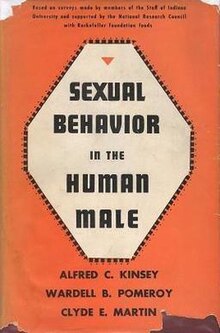
The Kinsey Reports are two scholarly books on human sexual behavior, Sexual Behavior in the Human Male[1] (1948) and Sexual Behavior in the Human Female[2] (1953), written by Alfred Kinsey, Wardell Pomeroy, Clyde Martin, and (for Sexual Behavior in the Human Female) Paul Gebhard and published by W.B. Saunders. Kinsey was a zoologist at Indiana University and the founder of the Kinsey Institute for Research in Sex, Gender, and Reproduction (more widely known as the Kinsey Institute). Jean Brown, Cornelia Christenson, Dorothy Collins, Hedwig Leser, and Eleanor Roehr were all acknowledged as research assistants on the book's title page. Alice Field was a sex researcher, criminologist, and social scientist in New York; as a research associate for Sexual Behavior in the Human Female, she provided assistance with legal questions.
The sociological data underlying the analysis and conclusions found in Sexual Behavior in the Human Male was collected from approximately 5,300 men over a fifteen-year period. Sexual Behavior in the Human Female was based on personal interviews with approximately 6,000 women. In the latter, Kinsey analyzed data for the frequency with which women participate in various types of sexual activity and looked at how factors such as age, social-economic status, and religious adherence influence sexual behavior.[3]
The two best-selling books were immediately controversial, both within the scientific community and the general public, because they challenged conventional beliefs about sexuality and discussed subjects that had previously been taboo.[4] The validity of Kinsey's methods were sometimes called into question. Despite this, Kinsey's work is considered pioneering and some of the best-known sex research of all time.[5]: 29
- ^ Sexual Behavior in the Human Male, ISBN 978-0-253-33412-1.
- ^ Kinsey, A.; Pomeroy, W.; Martin, C., & Gebhard, P. Sexual Behavior in the Human Female, Philadelphia: Saunders (1953), ISBN 978-0-253-33411-4.
- ^ Wolman, Benjamin B.; Money, John (1993). Handbook of Human Sexuality. J. Aronson. p. 131. ISBN 978-0-87668-775-8.
- ^ LeVay, Simon (February 1997). City of Friends: A Portrait of the Gay and Lesbian Community in America. MIT Press. p. 51. ISBN 978-0-262-62113-7.
- ^ Lehmiller, Justin (2018). The Psychology of Human Sexuality (Second ed.). John Wiley & Sons Ltd. p. 147. ISBN 978-1-119-16473-9.